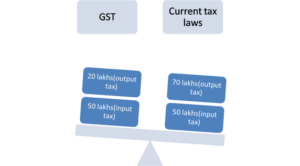What is Indirect Tax?
As the name suggests, Indirect tax is not directly levied on the taxpayers. In other words, the burden of such tax is transferable to someone else. This tax is often levied on goods and services which results in their higher prices. A few examples of such tax include service tax, central excise and customs duty, and value added tax (VAT).
What are common types of indirect tax?
Here are seven commonly imposed and the most widely applicable indirect taxes in India:
| 1 | Service Tax | Service tax is a tax which is levied on the services provided by an entity. Thus, if an entity is providing any service, they are required to levy service tax on the same. This tax is levied by entities for rendering services like consulting, legal, and other such services. This tax is collected from the service recipients and paid to the Central Government. Service tax is levied on all services except the services specified in the negative list of services. Apart from this, service tax exemption is allowed to small scale service provider. From 1st June 2016, service tax was 14% with Swachh Bharat Cess (0.5%) and Krishi Kalyan Cess (0.5%) bringing up the applicable rate to 15%. Small service providers with an income of less than INR 10 lakh per annum are exempted from paying this tax. |
| 2 | Excise Duty | This duty is applicable on all goods that are manufactured in India. The tax is payable by the manufacturers and often passed on to the customers. This indirect tax in India is levied by the Central Government and works according to the provisions of the Central Excise Act, 1944. |
| 3 | VAT | Value Added Tax (VAT) is imposed on the sale of movable goods in the nation. VAT is levied at all stages of the production and distribution channel that include an instance of value addition. The term ‘value addition’ implies the increase in value of goods and services at each stage of production or transfer of goods. Thus, VAT is a multi point destination based system of taxation. VAT is a tax on final consumption of goods or services and is ultimately borne by the consumer. This tax is levied by the State Governments under Entry 54 of the State List. The State Governments are carrying out the responsibility of levying and collecting VAT in the respecting states through taxation departments. |
| 4 | Custom Duty | It is one of those indirect taxes that are applicable for bringing imported goods into the country. In certain instance, this duty may also be levied on exported goods. The Customs Act, 1962 provides regulations on the levy and collection of this duty, import and export procedures, penalties, prohibitions, and offence. |
| 5 | Securities Transaction Tax (STT) | This tax is imposed when stocks are sold or purchased through any Indian stock exchange. STT was introduced in 2004 and is applicable to shares, mutual funds, and future and options transactions. STT was imposed to reduce the short-term capital gains tax and eliminate long-term capital gains tax. |
| 6 | Stamp Duty | This is an indirect tax charged by state governments on the transfer of immovable property within their jurisdiction. In addition, stamp duty is mandatory on all types of legal documents. Its rates vary from one state to another. |
| 7 | Entertainment Tax | It is reserved primarily for the state governments. The state governments charge such tax on every transaction related to entertainment. Some examples are movie tickets, video game arcades, stage shows, exhibitions, amusement parks, and sports-related activities. |
Apart from the above mentioned indirect taxes, there are several other indirect taxes in India as well like luxury tax, sales tax, octroi, etc.
What are the benefits of indirect taxes?
Four benefits of indirect taxes are:
| 1 | Contribution by the poor | The poor people are exempt from direct taxes and this is the only way of reaching this section of the society. This meets the basic principle of making every person pay towards the growth of the country through the state governments. |
| 2 | Convenient | Taxpayers are not burdened with the indirect taxes because these are paid only while making purchases. Furthermore, it is convenient for the state authorities because the taxes are directly collected at the factories or the ports, which saves time as well as effort. |
| 3 | Easy collection | The collection of all these taxes is automatically performed during the selling and purchasing goods and services. This helps the authorities collect taxes easily while reducing the possibility of tax evasion. |
| 4 | Equitable | This tax is directly related to the prices of the goods and services. Therefore, rich people purchasing luxury items pay higher taxes and vice versa. |
What are the disadvantages of indirect taxes?
Three disadvantages of indirect taxes are:
| 1 | Regressive | Not all taxes are equitable. Certain taxes, like that imposed on salt, are regressive because the same amount of tax is levied irrespective of the economic status of the buyer. |
| 2 | Uncertain | Only taxes imposed on necessary goods and services have some certainty. Taxes levied on goods and services having an elastic demand are not predictable and may not earn huge revenues for the authorities. |
| 3 | Not industry friendly | When tax is imposed on raw materials, it acts as a detriment to manufacturers using the same, thereby making it unfriendly. Furthermore, it increases the cost of production, which results in higher prices of the goods. |
 Because there are numerous indirect taxes in India, the buyers pay higher prices for goods and services. The Government is proposing combining various taxes under a single tax known as Goods and Service Tax (GST). Merging different taxes is expected to improve governance and reduce the complexities of complying with multiple rules and regulations.
Because there are numerous indirect taxes in India, the buyers pay higher prices for goods and services. The Government is proposing combining various taxes under a single tax known as Goods and Service Tax (GST). Merging different taxes is expected to improve governance and reduce the complexities of complying with multiple rules and regulations.

